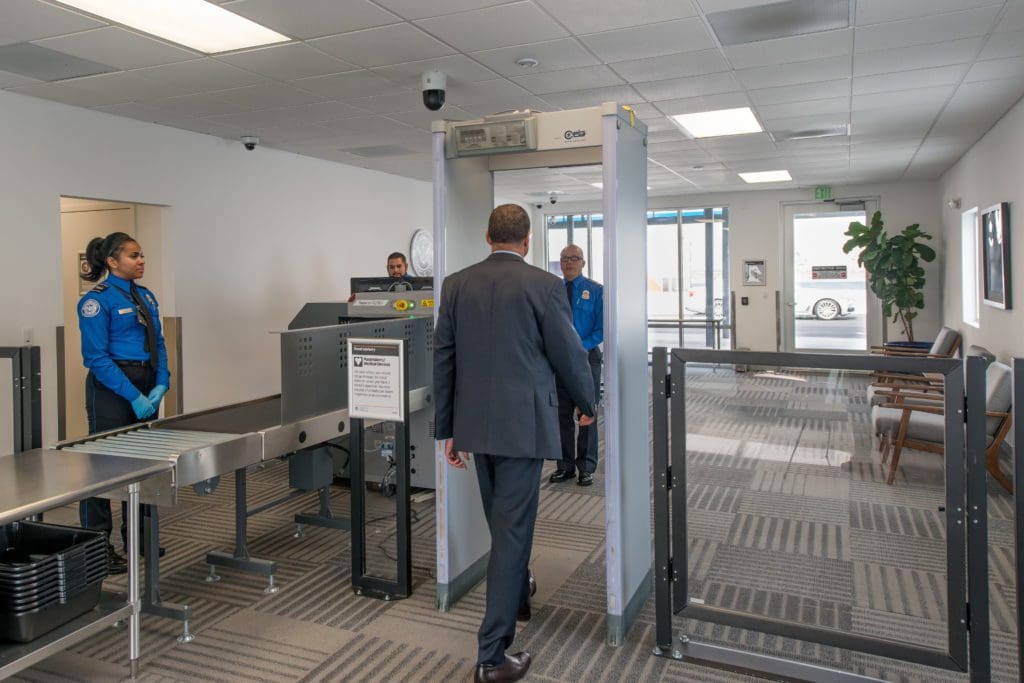
After three long months of rampant coronavirus spread, we are all pleased that travel restrictions are lightening, airline service is resuming, and more people are starting to fly domestically. If you haven’t flown since before the pandemic began, you need to know that the airport process has changed and to expect updated TSA Security Procedures.
The primary CDC recommendations for restricting the transmission of the virus are to limit physical contact and to increase physical distance. To follow those recommendations, airport procedures for travelers have changed from pre-COVID-19 times.
Social Distancing at the Airport
It is now recommended that travelers check-in online or with their airline’s mobile app to avoid physical contact with airport kiosks or handing documents to ticket agents. Similarly, using carry-on luggage eliminates any physical interaction of checking a bag.
Many airports require passengers to wear face masks inside. Shops and restaurants are gradually opening and some limit numbers of patrons at one time. BCD Travel created this infographic to support a seamless and safe experience at the airport.
Updated TSA Security Procedures
“In the interest of TSA frontline workers and traveler health, TSA is committed to making prudent changes to our screening processes to limit physical contact and increase the physical distance as much as possible,” David Pekoske, the agency’s administrator, said in a statement.
These updated TSA Security procedures are designed to reduce the potential for cross-contamination. They may increase the time it takes to clear security, so we recommend you arrive well in advance of your flight.
- Keep your boarding pass. You will now hold your boarding pass and ID out for the TSA officer to inspect it. He or she will not touch it. You will scan your boarding pass, either paper or electronic, across the reader yourself.
- Expired driver’s license and REAL ID extension – If your state-issued ID expired on or after March 1, 2020, and you are unable to renew, you may still use it as acceptable identification at TSA security up to one year after expiration. DHS has also extended the deadline for the REAL ID-compliant driver’s license to October 1, 2021.
- Separate food items for screening. Food often triggers screening alarms, so TSA requests that any carry-on food be in a clear plastic bag and placed in a separate bin. That reduces the likelihood that they will need to open your carry-on for closer inspection, protecting them, and touching your food container, protecting you. TSA Precheck members do not have to remove food.
- Know what you can carry on. To prevent contamination, place belts, wallets, keys, and phones in your carry-on for screening, rather than in bins. Be sure not to pack prohibited items, such as liquids in containers greater than 3.4 ounces. Note that TSA is now allowing 12 ounces of hand sanitizer per person, but you must remove it from your bag before screening. Laptops and larger electronics must be removed from carry-ons for screening (waived for TSA Precheck). If prohibited items are not removed, the traveler may be sent back outside security to remove them, causing a delay in clearing security.
- Practice social distancing. TSA security checkpoints vary at every airport; however, expect to see signs and floor labels encouraging social distancing. TSA officers may stagger security lanes or meter the admission of travelers into the line. Depending on the volume of passengers, these measures may make lines long and take more time for passengers to transit.
- Wear face coverings. Travelers are encouraged to wear face protection and may keep it on during the screening process. They may be asked to lower it to confirm identity. TSA officers will be wearing face masks, gloves, and in some cases face shields.
- Increased cleaning protocols – Employees will conduct increased routine cleaning and disinfecting of surfaces and equipment in the security area. TSA officers use a new Explosives Trace Detection swab for each person and will use a fresh pair of gloves upon request.
At the Gate and Onboard
Some airlines offer specific guidelines to travelers about mask requirements, health screenings, new boarding practices, onboard food service, and socially distanced seating. We recommend checking with your airline or your travel advisor in advance so you are well prepared.
Just as updated TSA procedures may require more time to clear security, social distancing protocols may increase boarding time. Plan to arrive at the gate earlier than you used to. You may also expect longer connection times between flights to accommodate the extra time passengers will need at the airport.
Some of these updated procedures may be temporary to assist in restarting air travel safely. Others are here to stay, so travel accordingly. For more information, contact your travel advisor.






Leave a Reply